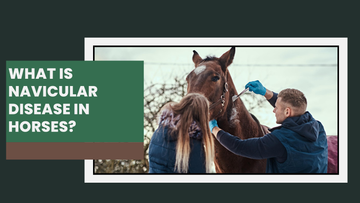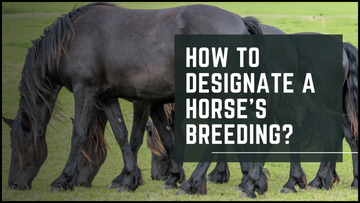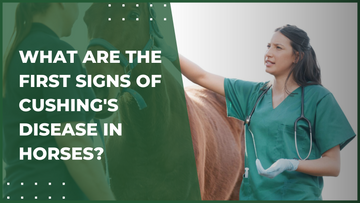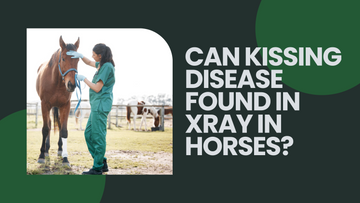If your horse starts showing signs of laziness, you might wonder what it is? Is it a navicular disease? But what is navicular disease in horses? Let's start with the basics and then we'll explore more details about it.
This condition occurs on the navicular bone and surrounding structures in the hoof. It’s a common concern in performance horses. So what exactly is going on?
Picture a small bone tucked within the horse’s hoof, called the navicular bone. It's got a tough job—helping manage pressure when your horse moves. But when it starts to wear down or its nearby structures get inflamed, it sends out quiet signals. At first, you’ll notice a shorter stride, maybe a stumble, or a horse that avoids hard ground.
Equine navicular issues often show up in both front feet. This makes it difficult to spot because your horse might not limp like you’d expect. Instead, they just look “off.” Sometimes, they’ll shift their weight from one front leg to the other, like trying to take the edge off the ache.
Want to know more about this navicular bursa infection? Let's get into the details right away!
Signs You Shouldn’t Ignore
Catching navicular disease in horses early can help you create comfort. Here’s what to look for before it becomes a bigger problem.
1. Short, Choppy Strides:
Horses with navicular syndrome often take shorter steps, especially on hard ground. You might notice it more on gravel—because that's when the pressure hits hardest on their heels. Horses with navicular troubles instinctively try to lighten the load on that sore spot. What looks like a training issue might be their way of saying that it hurts.
2. Tripping or Stumbling:
A horse dealing with equine navicular problems might lose balance more often. The pain in the hooves affects coordination. And the surface doesn’t seem to matter. Even a flat paddock becomes a challenge. Why? That discomfort in the hooves can mess with how they place their feet, making balance feel like a tightrope act.
3. Shifting Weight from Foot to Foot:
Watch how your horse stands. If they keep shifting weight between their front legs or avoid putting full pressure on a hoof, it might be because of navicular disease in horses. These aren’t random movements. Horses do this to dodge the pressure that’s building up deep in their hooves—often right around the navicular bone.

What Causes This Condition?
Here’s what affects the development of navicular disease in horses.
1. Pressure on the Navicular Bone:
The navicular bone equine system is a shock absorber in the hoof. But just like a well-used spring, too much weight or constant pounding starts to wear it down. Horses that carry heavy riders, work on hard ground, or have a naturally heavy front end are more prone to this. Over time, the bone doesn’t just get sore—it gets inflamed.
2. Repetitive Hard Work:
Horses used for jumping, barrel racing, or other high-impact activities put excessive strain on their front hooves. The repeated shock from landing and quick changes contributes to the weakening of the navicular bone equine structure. When that shock hits again without enough rest or variation in terrain, more body issues build up until the horse starts showing pain.
3. Shoeing and Trimming:
Showing that it doesn't support natural hoof mechanics can increase stress on the navicular bone equine system. If a horse’s hooves are trimmed too short or shod incorrectly, it may increase the strain on the back of the hoof. It changes how they walk, shifts pressure to parts that aren’t meant to take it, and leads to strain. But shoeing a horse with navicular disease gives them hoof space to function.
Diagnosis: Getting the Right Assessment

Check how veterinary doctors diagnose it and then plan equine navicular treatment accordingly.
1. Recognize Lameness:
Horses with navicular bone equine disease may start showing intermittent lameness that worsens on hard ground or after exercise. Some horses even seem totally fine in the stall but start limping the moment they’re saddled. That’s because the added weight or firm ground magnifies the pain that’s already been simmering. If it feels like they’re “off” but you can’t quite point to why—then you must talk to your veterinary doctor.
2. Horse Hoof Testing for Pain Response:
A hoof tester is used to check for soreness in the back of the hoof. Horses with navicular in horses react to pressure in this area. Vets or experienced farriers use this tool to gently squeeze different parts of the hoof, especially around the heel area. A flinch, a snatch of the leg, or a pinning of the ears when pressure is applied to the back of the foot? That reaction can be one of the earliest outward signs of high pain tolerance.
3. Flexion Tests to Spot Stiffness:
A vet gently bends the leg in different directions, just enough to mimic the kinds of movements horses do every day. What’s telling is the reaction after: does the horse limp more after the stretch? Pull away quickly? These tests zero in on stiffness, especially around the coffin joint and navicular area.

Treatment Options for Relief
With the right care, horses can maintain an active lifestyle while reducing the impact of navicular changes in horses.
1. Joint Injections:
Steroid injections into the coffin joint or navicular bursa are good for pain relief. Veterinarians may also combine steroids with hyaluronic acid or regenerative therapies, such as platelet-rich plasma (PRP). It will lower down the inflammation right at the source. This is the new treatment for navicular in horses that go deep into either the coffin joint or navicular bursa, areas not easy to reach but critical for relief.
2. Shockwave Therapy:
Shockwave therapy sends sound waves into affected areas. It has been used to relieve pain and promote healing in ligaments. Many owners say their horse starts moving with more freedom within a couple of sessions. Also, this therapy can help trigger the release of growth factors in the area—something the horse’s body might not do well on its own.
3. Blood Flow Medications:
Drugs like isoxsuprine and pentoxifylline allow more oxygen to reach the navicular bone. They are prescribed as part of an approach to improve hoof health. It also helps more oxygen-rich blood reach the bone, especially when circulation slows down in the tiny vessels inside the hoof.
Preventive Measures to Protect Hoof Health
A few habits go a long way in protecting their hooves from unnecessary stress and wear. So, here's what you can do:

1. The Right Terrain for Hoof Strength:
Horses moving constantly on hard, uneven ground experience more impact on their hooves. Pastures should have both grass and soil to support natural movement. If riding on tough terrain, you can use hoof boots or protective pads.
2. Horse Weight Control:
Extra weight puts unnecessary stress on a horse’s hooves. A feeding and exercise plan maintains a healthy body condition. You can monitor body weight and adjust feeding routines as needed to prevent long-term hoof issues.
3. Protective Hoof Boots for Extra Comfort:
For horses with navicular changes, hoof boots provide additional support by absorbing shock on hard surfaces. They are useful for horses recovering from navicular syndrome treatment.
Long-Term Care and Management
Here's how you can manage equine navicular symptoms:
1. Farrier Visits:
Hooves that are too long or imbalanced create extra strain on the navicular bone, worsening discomfort. Shoes such as bar shoes or wedges can help shift weight off sensitive areas. Routine evaluations allow farriers to make necessary adjustments to improve the horse’s comfort.
2. Therapeutic Exercise to Keep Muscles Active:
Gentle riding, swimming, and structured groundwork exercises keep them active without overloading their hooves. Walking on terrain encourages natural hoof function while preventing stiffness. Overworking a horse can worsen symptoms, so activity should be adjusted based on their comfort level.
3. Riding Smart to Avoid Unnecessary Strain:
Horses with navicular changes in horses require careful consideration when it comes to riding. Hard, rocky surfaces increase discomfort, while deep footing can cause additional strain. Choosing even terrain reduces impact and makes movement more comfortable.
Lighter rides with shorter durations prevent unnecessary stress while keeping them active. Observing how a horse responds to different surfaces helps owners adjust activities accordingly.
Conclusion:
What is navicular disease in a horse? Now that you know all the answers, let's recap.
With the right strategy, many horses continue to lead active lives despite the condition if the treatment given to them is good. They need hoof care, controlled exercise, and medical support to reduce pain. Owners who stay proactive in treatment can improve their horse’s comfort and well-being. Alternative therapies, radiographs, corrective shoeing, and some lifestyle adjustments allow many horses to remain comfortable for years.
If you are looking to take early intervention with the best horse products and help your animal in the movement, visit The Epic Animal. To grab the products at discount, visit the website today.
FAQs
-
When to euthanize a horse with a navicular?
Euthanasia is considered when pain management no longer helps, and the horse struggles with daily movement. A vet’s guidance ensures the most humane choice.
-
Is navicular genetic?
While not directly genetic, some horses inherit poor hoof conformation that increases the risk of navicular changes in horses over time. Proper hoof care lowers this risk.
-
How long can a horse live with navicular?
With the right navicular syndrome treatment horses, many horses live comfortably for years. Early care, correct shoeing, and therapy slow progression and ease discomfort.
-
How common is navicular disease in horses?
It’s more common in certain breeds, especially those with upright pasterns or small hooves. Regular hoof maintenance helps reduce the chances of navicular changes in horses.
-
Is navicular disease in horses hereditary?
There’s no direct hereditary link, but conformation traits that increase risk can be passed down. Managing hoof balance from a young age helps prevent issues later.
Read More Blogs:







